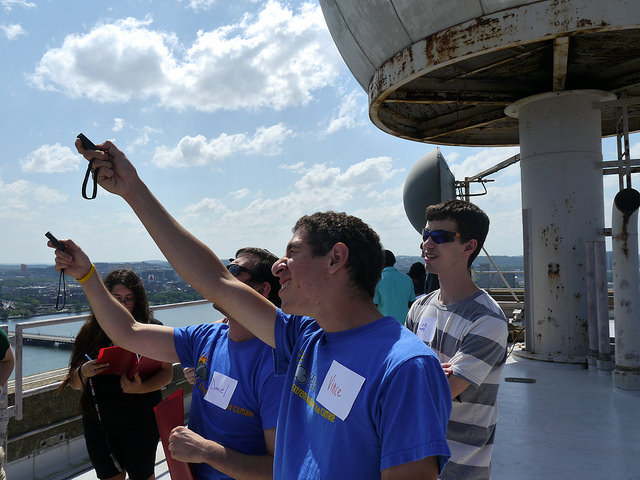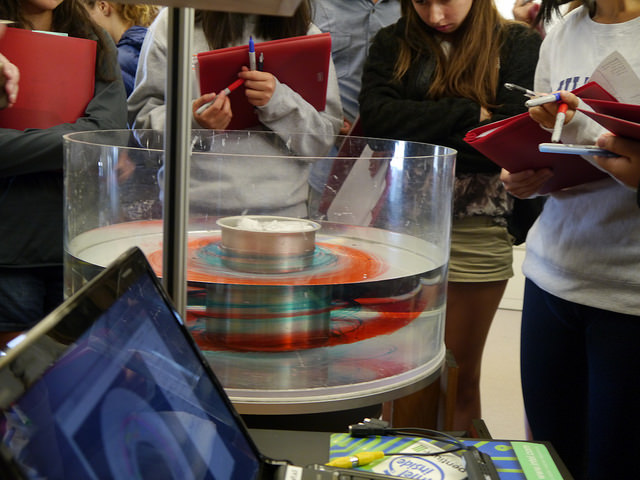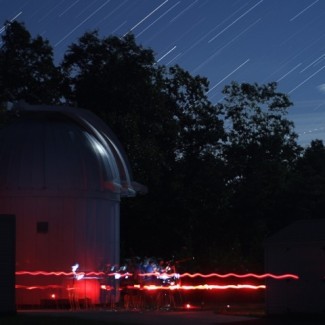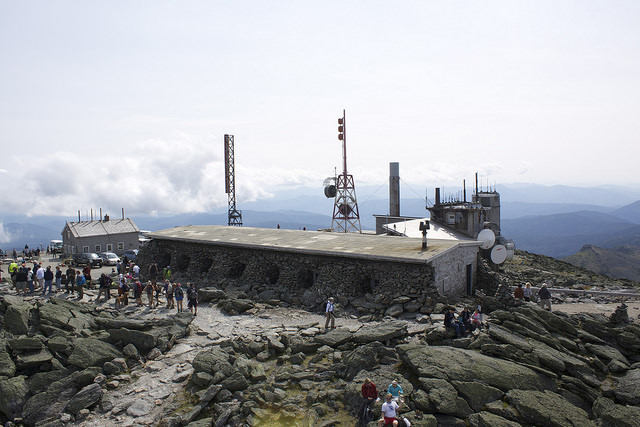PAOC Spotlights
New Students Discover EAPS through Extreme Weather and Climate
Before the new semester began, incoming freshmen joined EAPS for a 5-day exploration of extreme weather and climate.
***
Every year, MIT welcomes incoming freshmen with FPOP—a pre-orientation program aimed at introducing students not only to one another, but also to the Institute’s diverse research. The Department of Earth, Atmospheric, and Planetary Science (EAPS) is a prime example of such diversity, housing a variety of natural science fields under the same roof. This year, students joined the department on two FPOP trips—one to Yellowstone National Park and the other to New Hampshire’s Mount Washington—because one is not enough to represent all EAPS has to offer.
“I decided to apply for DEAPS because climate, geology and astronomy have always been interesting to me but I've never been able to study it in any great detail,” said Anna Sappington, an incoming freshman interested in computational biology and chemical engineering. “I thought it would be a really neat way to explore an interest area and meet new MIT freshmen.”
 Approximately 20 students joined the Mount Washington program for a 5-day exploration of extreme weather and climate. The program kicked off on the roof of the Green Building, where the incoming freshmen joined MIT Meteorologist Lodovica Illari for a lesson in applied physics. Tasked with measuring the building’s height and with no tape measure in sight, the groups turned to famed physicists Isaac Newton and Blaise Pascal. Newton’s method called for dropping an object—in this case oranges and cantaloupes —from the roof, timing their fall, and using known gravitational acceleration to deduce height. Pascal’s method on the other hand, was less messy. Students measured atmospheric pressure on the building’s roof and at its base, careful to avoid splattering fruit, and plugged their measurements into a hydrostatic balance equation to estimate height. While neither method yielded 277 feet exactly, the students came very close.
Approximately 20 students joined the Mount Washington program for a 5-day exploration of extreme weather and climate. The program kicked off on the roof of the Green Building, where the incoming freshmen joined MIT Meteorologist Lodovica Illari for a lesson in applied physics. Tasked with measuring the building’s height and with no tape measure in sight, the groups turned to famed physicists Isaac Newton and Blaise Pascal. Newton’s method called for dropping an object—in this case oranges and cantaloupes —from the roof, timing their fall, and using known gravitational acceleration to deduce height. Pascal’s method on the other hand, was less messy. Students measured atmospheric pressure on the building’s roof and at its base, careful to avoid splattering fruit, and plugged their measurements into a hydrostatic balance equation to estimate height. While neither method yielded 277 feet exactly, the students came very close.
The next set of activities gave students a basic introduction to atmospheric and ocean circulation. Using data from 2008’s Hurricane Bertha as well as measurements from a swirling water vortex in EAPS’ fluid dynamics laboratory, the incoming freshmen calculated the Rossby number typical of the fluid motion in the observed vortices. Scientists use this non-dimensional number to assess dominant forces acting on vortices such as hurricanes, rotating storms seen on daily weather maps, and ocean eddies on the edge of the Gulf Stream.
In the rotating fluid lab, MIT Oceanographer John Marshall brought atmospheric circulation to life using ‘Weather in a Tank’—a signature feature of education in the department. Students gathered around a rotating tank of water with an ice bucket at its center. The apparatus shows how Earth’s rotation creates systems that affect temperature differences between the warm tropics and cold poles. The bucket of ice forms a temperature gradient in the water—cold near the bucket (pole) and warm near the edges (equator)—and the tank’s rotation forms different currents depending on speed. These currents, which can be seen with just a few drops of food coloring, resemble weather patterns and moderate the tank’s temperature gradient. Varying the rotation speed of the tank and the temperature gradient, students sketched their weather pattern predictions and observations, and discussed where in the atmosphere the currents might be found.

Interspersed throughout the hands-on experiments were a series of lectures given by MIT faculty and students on hot topics such as climate, weather forecasting, extreme weather, and even the intersection of science and the humanities. Professor Noelle Selin gave the key note about her research, which focuses on using atmospheric chemistry modeling to inform decision-making policies on air pollution, mercury pollution, and climate change. Students not only learned about the department’s research, but also how that research can be used to effect change in the world.
“[DEAPS] encouraged me to pursue my interests in course 12,” said Jordan Benjamin, an incoming freshman interested in physics and atmospheric science. “It's a good look into what you could actually do, what the different fields are and why they matter. It really helps getting your hands on things and getting a feel for the science EAPS has to offer.”
 There’s more to EAPS than just the Earth, its oceans and atmosphere—just ask Amanda Bosh, a senior lecturer in the department. As the sun set behind the Boston skyline, Bosh and students headed for Wallace Observatory where they were terated to views the solar system through large telescopes and talked about current research. Bosh and colleagues predict and track stellar occultations—when light from a star is blocked by an intervening body, in this case Pluto and Kuiper belt objects—which are used to probe ring systems and atmospheres in the outer solar system. Researchers also use the telescopes at the oservatory to monitor extrasolar planet transits and measures asteroid light curves to determine their shape and spin, among other things.
There’s more to EAPS than just the Earth, its oceans and atmosphere—just ask Amanda Bosh, a senior lecturer in the department. As the sun set behind the Boston skyline, Bosh and students headed for Wallace Observatory where they were terated to views the solar system through large telescopes and talked about current research. Bosh and colleagues predict and track stellar occultations—when light from a star is blocked by an intervening body, in this case Pluto and Kuiper belt objects—which are used to probe ring systems and atmospheres in the outer solar system. Researchers also use the telescopes at the oservatory to monitor extrasolar planet transits and measures asteroid light curves to determine their shape and spin, among other things.
“One of my favorite parts of the whole experience was the observatory,” said Sappington. “It was neat looking through 24 and 16-inch telescopes, seeing images from that, seeing how astronomers operate the telescopes, and learning about the research and research opportunities there.”
During the program’s final two days, students and faculty abandoned MIT’s campus for New Hampshire’s Mount Washington—the highest peak in the Northeastern United States boasting fascinating geology and erratic weather conditions. The night before beginning their ascent, students took advantage of the low light pollution to stargaze. “There was a full moon so the sky wasn't as dark as they were hoping, but we got to see the moon,” said undergraduate TA Elizabeth Berg.

As students ascended Mount Washington the next morning, they took meteorological observations and discussed the mountain’s ecosystem and geology. At the top where extreme weather is the norm, students toured the meteorological observatory before venturing on a hike around the mountain.
“We descended 1200 feet over an extremely rough trail to the Alpine Garden,” said Jeff Scott, a research scientist in EAPS and hike leader. “This is an ecosystem of extremely hardy plants, and alpine tundra biome with many tiny, rare alpine flowers.” Graduate students gave a short lecture on the garden flora and the mountain’s geology, after which the hike continued part way around the mountain and back to the summit.
Although the group had to navigate a physically demanding terrain of rocks and boulders, they also encountered some unique surroundings. “The views were gorgeous at first, and then we walked through a cloud,” said Berg. “It was one of those things where you could see the cloud coming and then all of a sudden you're in it. You don't realize that you're in the cloud at first because you can't really see out, then it passed. It was really cool.”

Throughout the hike, students applied some of their new atmospheric knowledge to estimate the height of the mountain and observed how different geologic forces such as plate tectonics, metamorphism, glaciation, weathering, and water erosion shaped the picturesque landscape. After reaching the summit again, everyone took some time to enjoy the view and reflect before heading back to the lodge.

Before departing for MIT the following morning, students enjoyed the landscape at Diana's Bath—a spectacular set of cascades and pools. Under the expert guide of Ming Ding, a geophysics postdoc in EAPS, they had a final lesson on the unique geology of the area.

“Besides the knowledge we gained academically, we also learned a lot about the professors and the research here at MIT,” said Nancy Wang, an incoming freshman interested in climate and energy. “The professors were approachable and didn't have expectations for you to know everything. It was nice that they catered to people of all levels of background knowledge,” she said. “It’s good to know that the people around you at MIT are all here to help you. DEAPS was a really amazing experience, and I would highly recommend it to incoming students next year.”
Program coordinator Lodovica Illari echoed that sentiment, adding, “Everything went very smoothly and we even had a professional photographer with us because our trip to Mount Washington was chosen by the Institute as an example of teaching outside the classroom.” She hopes to attract even more freshmen next year.
Read about the DEAPS Yellowstone trip here, and view more photos on flickr.